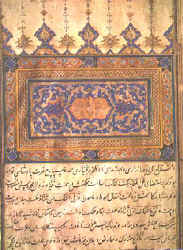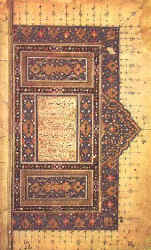|
History of Turkistan in the medieval manuscripts
and written sources
In the Arab-Persian sources Turkistan appears in the IX - X centuries. These sourcesname Turkistan as Shavgar. The Arab traveller al-Istarkhi writes: "from Keder to Shavgar is one-day journey, from Shavgar to Savran is one-day journey". Al-Istarkhi also informs that the people of Shavgar were converted to Islam by the Samanid ruler Akhmed ibn Asad in 245/859, during this event several thousand of the town residents were beaten unmercifully. At-Tabary in his "History" writes that people of Shavgar already in 135/755 were Muslims, and they were allies of the Alids in their fight against the ruler of Bukhara Zinad ibn Salikh and the ruler of Khurasan Abu Muslim. During this war Abu Muslim sent the army to struggle against Shavgar headed by of ibn an-Nadim.
 According to the messages provided by al-Makdisi, "Shavgar is a large city, with mounds around it, and there is a mosque at the edge of the market." Ibn Yakut writes, "Shavgar is a Turkic town". According to the messages provided by al-Makdisi, "Shavgar is a large city, with mounds around it, and there is a mosque at the edge of the market." Ibn Yakut writes, "Shavgar is a Turkic town".
According to "Nasab-name", Akhmed Ata Yassawi from Sairam arrives to the land of Yasy. At the beginning of the XIII century in Yasy the Kwarazm Shah Mukhammed ibn Tekesh minted silver coinage under his authority.
The name of Shavgar has not been appearing in the sources dated after the X century. And the name Karachuk Asan appeared for the last time in the diary of the Armenian tsar Getum, on his way to the residence of the Mongolian Khan in Karakorum.
At the end of the XIV century in "Zafar-name" by Sharaf ad-Din Yezdi the name of Yasy is mentioned, indicating that "Yasy is a small settlement, there is the tomb of the Sheikh Akhmed Ata Yassawi there". From that time in the medieval sources Turkistan figures as Yasy. Molla Shadi in his poem "Fatkh-name", devoted to the Shaibanid Khan Mukhammed Shaibani, writes about the conquest of Yasy and Otrar by Mukhammed Shaibani Khan and about Mukhammad Marid Gurkhan, the Khakim (ruler) of the town.
The data about Turkistan are founded in the works of Kamal ad-Din Ali Binai "Shaibani-name", Mukhammad Khaidar Dulati "Tarikh-i Rashidi", Makhmud ibn Vali "Bakhr al-Asrar", Masud Kukhistani "Tarikh-i Abul-Khairkhani", Fazlallakh ibn Ruzbikhan Isfakhani "Mikhman-name-yi Bukhara" and in other sources. These sources describe the events that took place from the XIV to the XVII centuries in Desht-i Kypchak, Moghulistan. And the above sources keep mention about the town and okrug of Turkistan.
 Judging from the data provided by the written sources, Turkistan was the hereditary udel (independent domain) of ancestors of the first Kazakh rulers. Before the accession to power of Abulkhair in Desht-i Kypchak, the Djanibek's father Barak possessed by Sygnak and other towns near Syr Darya. It is known about his message to Ulugbek demanding to return a number of Turkistan towns that Timur earlier had conquered from Djuchids. This demand was grounded by the reference to the activities of his ancestors related to the improvement (equipping with services and utilities) of these towns, including the reconstruction of Sygnak by Urus-khan. Utemish-khadji in "Chiggis-name" informed that Urus-khan was the great sovereign, and "governed the vilayets of all Turkistan". Judging from the data provided by the written sources, Turkistan was the hereditary udel (independent domain) of ancestors of the first Kazakh rulers. Before the accession to power of Abulkhair in Desht-i Kypchak, the Djanibek's father Barak possessed by Sygnak and other towns near Syr Darya. It is known about his message to Ulugbek demanding to return a number of Turkistan towns that Timur earlier had conquered from Djuchids. This demand was grounded by the reference to the activities of his ancestors related to the improvement (equipping with services and utilities) of these towns, including the reconstruction of Sygnak by Urus-khan. Utemish-khadji in "Chiggis-name" informed that Urus-khan was the great sovereign, and "governed the vilayets of all Turkistan".
As the written sources inform, from the XIV to the XV centuries Kypchaks, Kangles, Argyns, Dulats, Jalairs, and also representatives of the other Turkic tribes, taking part in ethnogenesis of Kazakhs and Uzbeks, lived in Turkistan. The sources of that time clearly determine the borders of Turkistan. In particular, Ruzbekhan Isfakhani states, that the stronghold Arkuk is considered to be the beginning of Turkistan, this stronghold is situated one farsakh (measure of distance) off Syr Darya. A road to the eastern strongholds of Turkistan passes through Arkuk. The town of Sygnak was a frontier point of Turkistan. Here, behind Sygnak Turkistan ends.
Being close to Mukhammed Sheibani, Ruzbekhan took part in his campaign of 1509. Here is his description of Turkistan: "The land of Turkistan is one of well-known populated areas and regions. Judging from its advantages and peculiarities, it is really a rarity on the earth. The wise and learned people throughout the world compare the land of Turkistan with a head because the picture of the world structure as a human being and determining the correspondence of each part of the world to the parts of a human body requires of this blessed area to be the head among other lands to that the functions of other parts of a human body are ascribed. Turkistan consists of thirty strongholds situated along the bank of the Seikhun river. Kamal ad-Dina Ali Binai in "Shaibani-name" mentioned that they (Shaibani and his followers) went to "vilayat Turkistan" that included such well-known towns as Sygnak, Sauran, Otrar, Yasi, Sairam, Arkuk, Uzgend, Ak-Kurgan, Suzak and other towns located in the Syr darya river basin. In XV-XVI centuries the Turkistan lands were the arena of the hardened struggle of Shaibanids and the Kazakh Khans for the power over the nomadic tribes. Namely this region has played a major role in the formation of the Kazakh state system.
|

